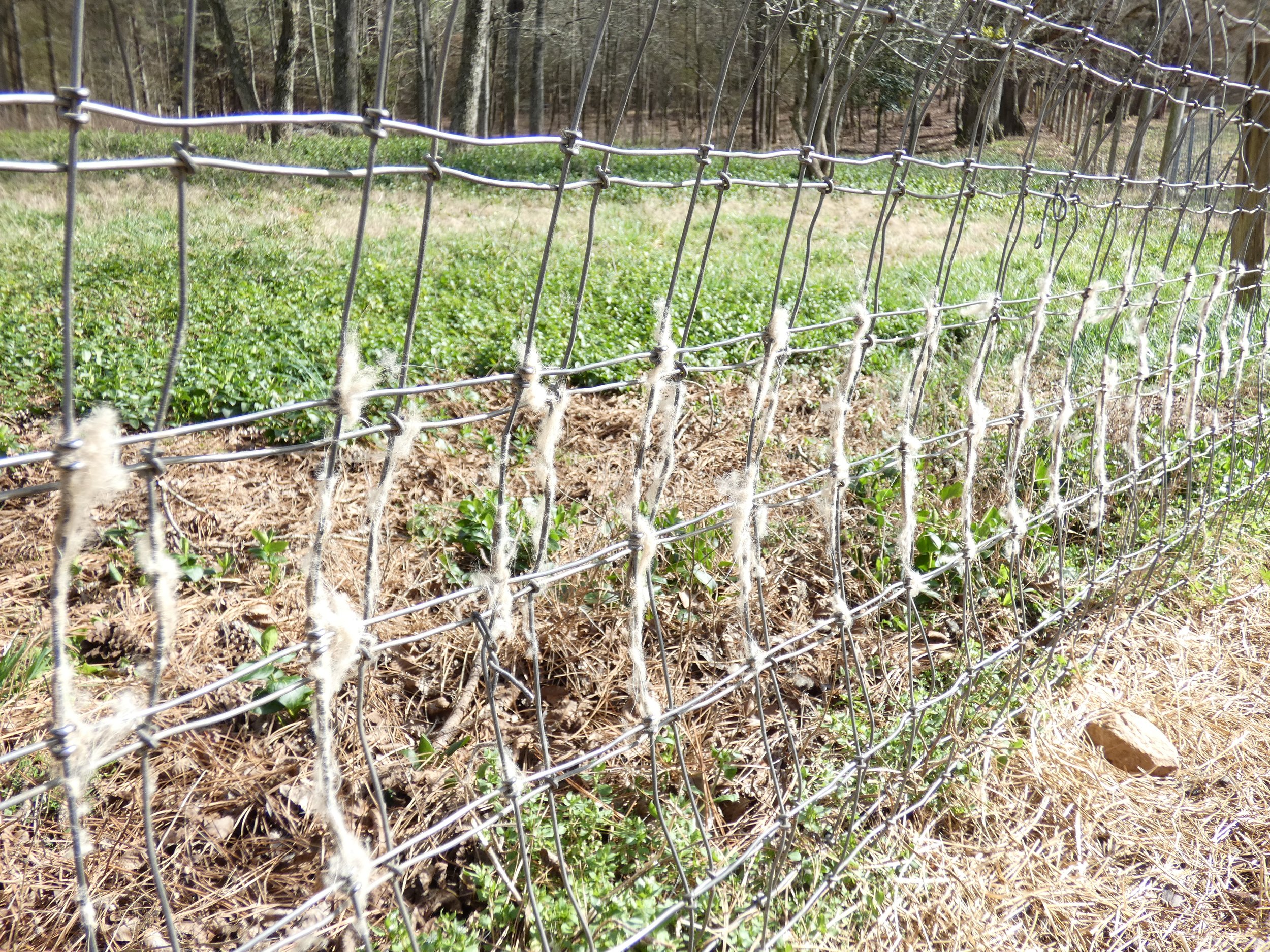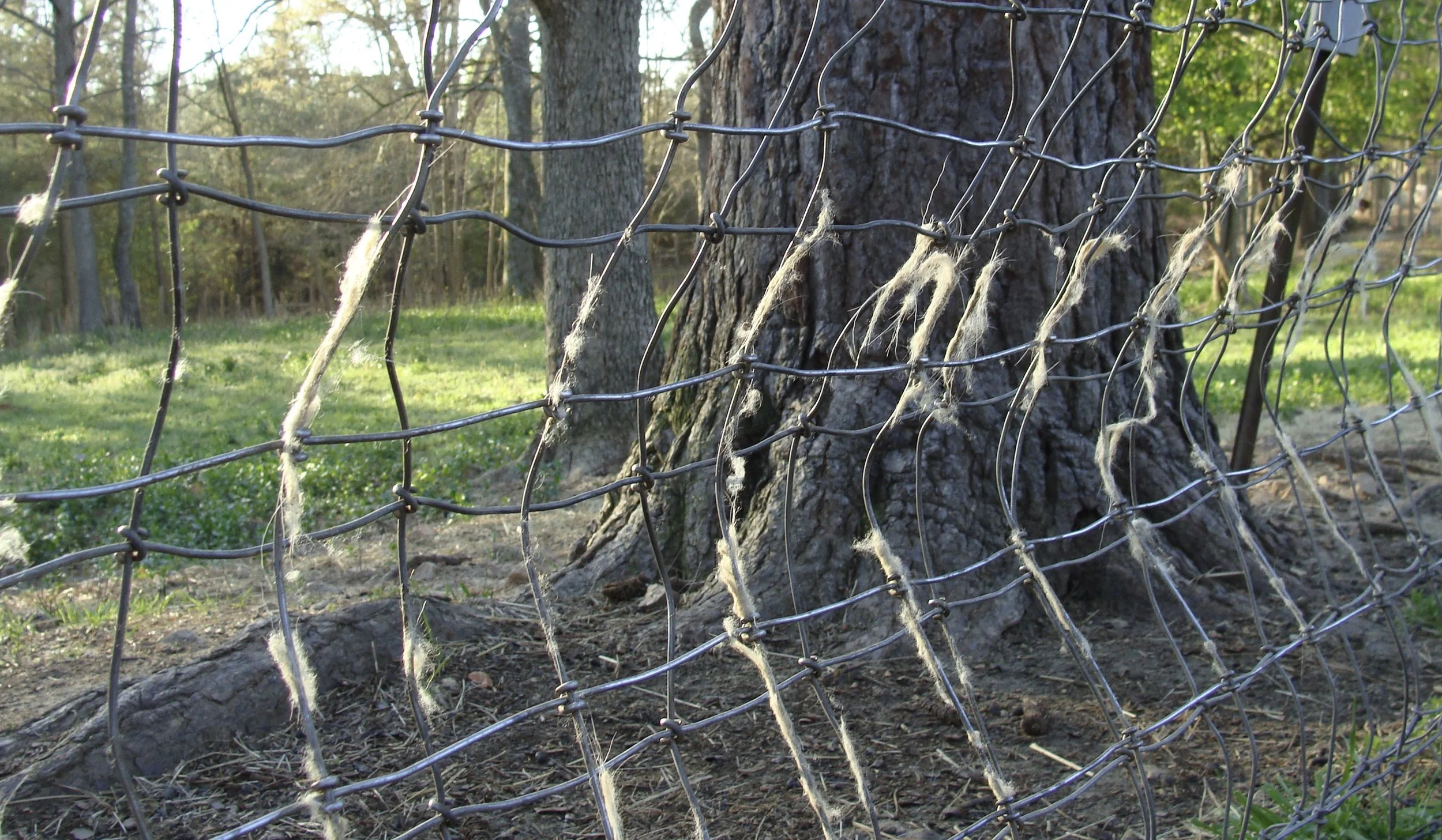Cashmere Dehairing
Today’s post is a follow-up to ‘Cashmere Gathering’, which I published a while back. In that article, I wrote about the history and characteristics of cashmere and about collecting cashmere from my own goats. Readers wrote asking me how I dehair and prep my harvested cashmere. So, in this post, I'll share my process.
WHEN DO YOU GATHER THE FIBER?
In January, I start to see the "signs" that I could gather. Literally, cashmere, or downy undercoat, begins to surface on the goat's outer hairy coat. You can see the fuzzy white down on Spot's black neck hair.
Another telltale sign is what I call 'flagging'. The shedding must be itchy because the goats use their built-in back scratchers (horns). Bits of fiber stick on the horn tips and wave in the wind like tiny flags on a flagpole. I circled in green Cotton Tail sporting her 'flag'.
The other way to scratch that itch is to rub along the pasture fencing. I collected this fiber in the past but often found it matted from the weather and repeated rubbing.
I live in the southern United States, winters are generally relatively mild. Our nightly lows may get down to the twenties (Fahrenheit) in January and February, with daytime highs typically in the forties to sixties (Fahrenheit). So when cashmere can be gathered in your area may differ depending upon your climate.
HOW DO YOU COLLECT THE FIBER?
Some sheep breeds, for example, Icelandic and Shetland, are not shorn but rather roo. Rooing, also known as wool break, is a process in which these particular sheep breeds shed their heavy coat of wool in the springtime. Traditionally Shetland sheep fleeces are plucked with the break.
I have not seen the term "rooing" to describe goat fiber, but it is similar. I don't really pluck the down from my goats as I've found this gives me fiber with more unwanted guard hairs. Instead, I comb the goats with a dog comb.
Some goats love to be combed. Divas, like Maggie, would stand there all day as if receiving a spa treatment. Other gals enjoy a quick grooming session. And then there are those who I comb while they are distracted eating the morning grain feeding.
In general, the goats are pretty used to me combing them. I comb year-round for practical reasons such as to remove any matted hair and to inspect their coats for mites. Also, the combing process is one of the many rewards of farming; interacting with our animals one on one brings great joy!
This is some cashmere I combed this morning. I'll demonstrate what I do with this lovely but hairy pile of fluff in the following video.
You may want to enlarge the video to full screen to see the process easier.
Here is a photo of the fiber before and after dehairing.
This is a closeup of the waste I removed: clumps of fiber that are mostly hair-filled, small little neps or mats of fiber, the coarse guard hairs, and tiny speckles of vegetative matter (VM).
WHAT IS THE FIBER LIKE?
It is very, very soft and extremely lightweight. The handful in my palm weighs 2 grams (.05) ounces. It is short stapled; to me, it is comparable to cotton. It does not contain lanolin like sheep's wool. Therefore, I do not wash it as a part of fiber preparation.
Regardless of hair color, all of my goats produce whitish cashmere ranging from cream white to a light beige white. Those goats with grey or black coats may also have some darker gray to taupe, as seen in the bottom left of the photo above.
DO ALL MY GOATS PRODUCE CASHMERE?
In my earlier blog post on Cashmere Gathering, all goats, except Angora goats (which produce mohair), have cashmere. However, the amount and quality of that will vary. We started our herd with three does. Two of the females are purebred Saanen. Saanens are beautiful white goats known for their exceptional milk production. My Saanen girls, Lily and Daisy May, produce very little cashmere.
Our leading baby daddy is Zig, a purebred Nigerian Dwarf buck. He has a long, thick outer coat and plenty of downy cashmere undercoat. The offspring of the Saanens and Zig have varying amounts of cashmere, some very little and some enough to comb and harvest.
Jill is the third of our original does. She mixes many breeds, including Nigerian Dwarf, Pygmy, Alpine, Nubian, and Boer. She has beautiful cashmere, and her babies and grandbabies produce my best cashmere in both quantity and quality.
Jill’s line of cashmere is on the left. It is relatively longer stapled, fluffy, and significantly less hairy per volume of usable fiber. The Saanen line of cashmere is on the right for comparison.
DO I HARVEST ONLY FEMALE CASHMERE?
Yes! My Zig is a sweet, funny, lovable guy for most of the year. But then, in late Fall through mid-February, the "rut" arrives, and he becomes a totally different goat, more of a warthog. During the rut, he is single-minded on increasing the world's population with his progeny. As the rut and cashmere gathering season overlap, there are several reasons that I don't harvest his fiber. Apparently, goats find grungy bucks particularly attractive, especially those that urinate all over their beard and coat. Also, Zig's sweetness becomes a little masked by his testosterone, and thus he has butted me a few times during the rut. Being a little guy, this has been more like a bump rather than a full butt, yet I don't want to press him! He loves to be combed at other times of the year, and we bond then!
HAVE YOU PREPPED YOUR CASHMERE?
I have done a little bit of carding. As I mentioned above, the fiber is short and reminds me of cotton. I have used small hand cards of tpi 110 (tines per inch).
I've rolled these into little rolags or punis. I think I may try blending it with another fiber, probably a fine wool before I spin it for the first time.
It’s a tedious process, but I enjoy it!
























